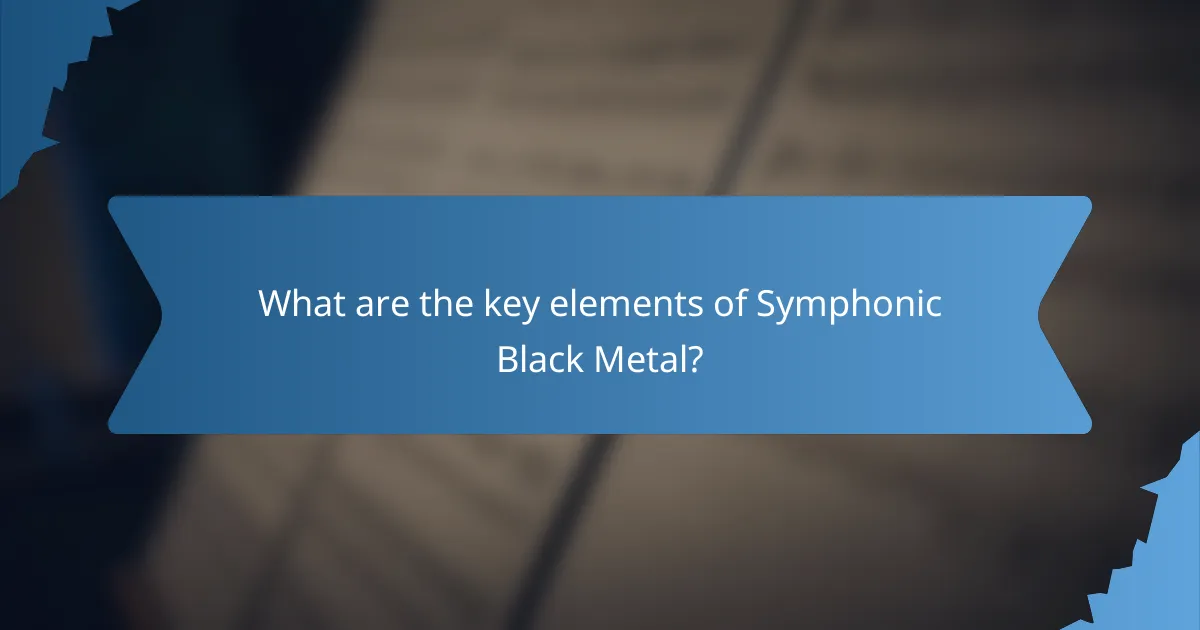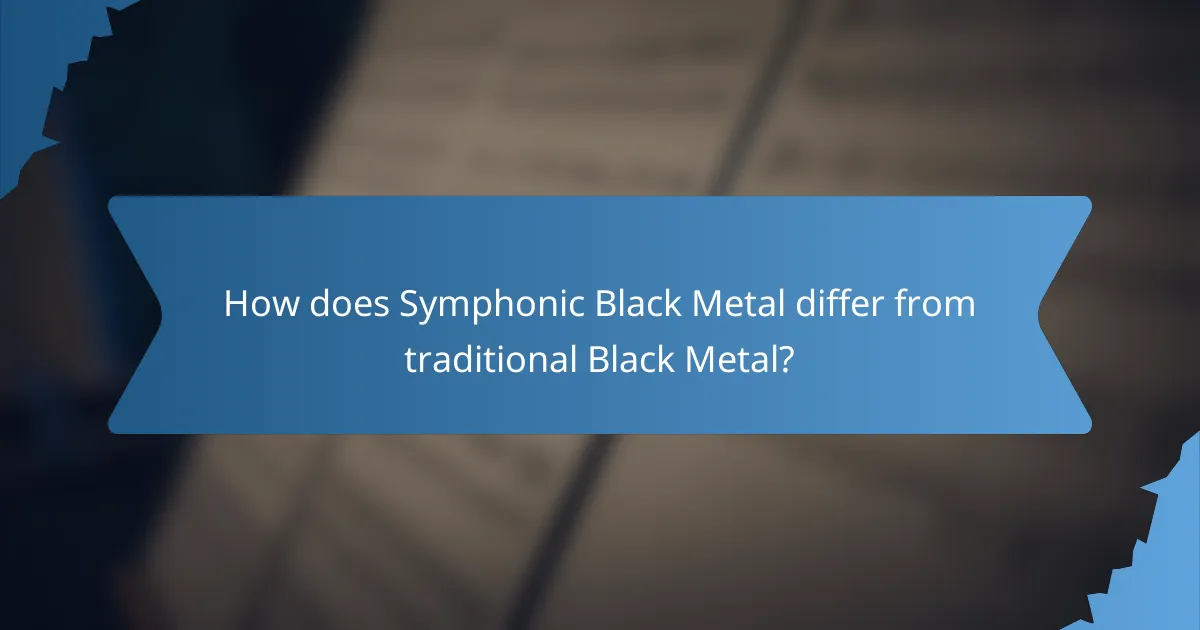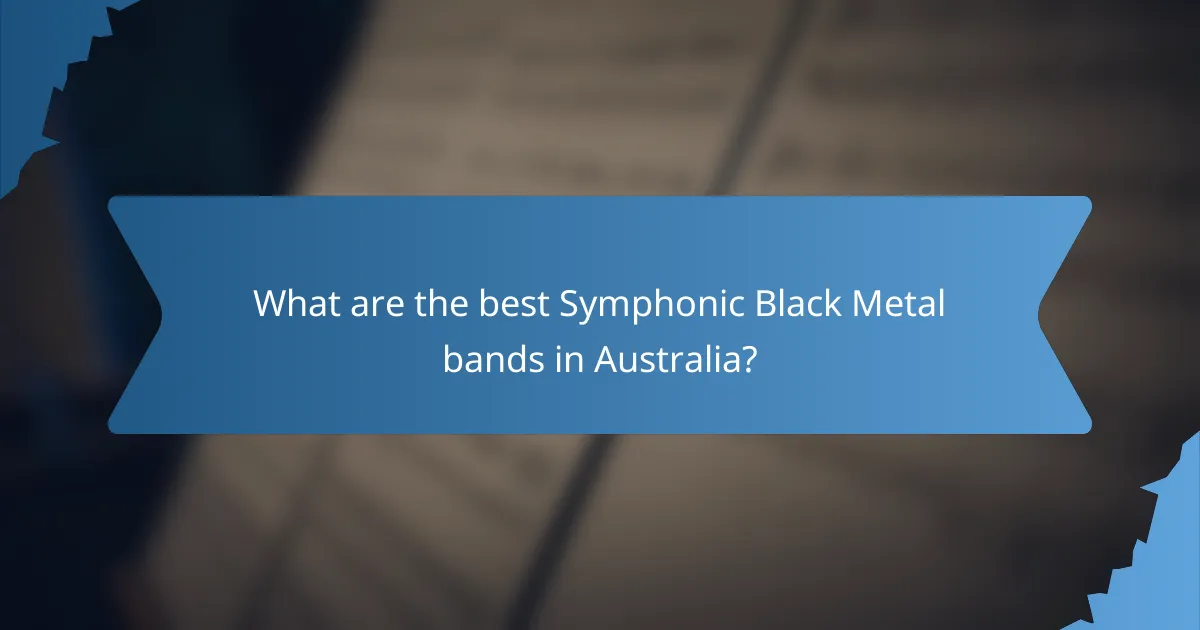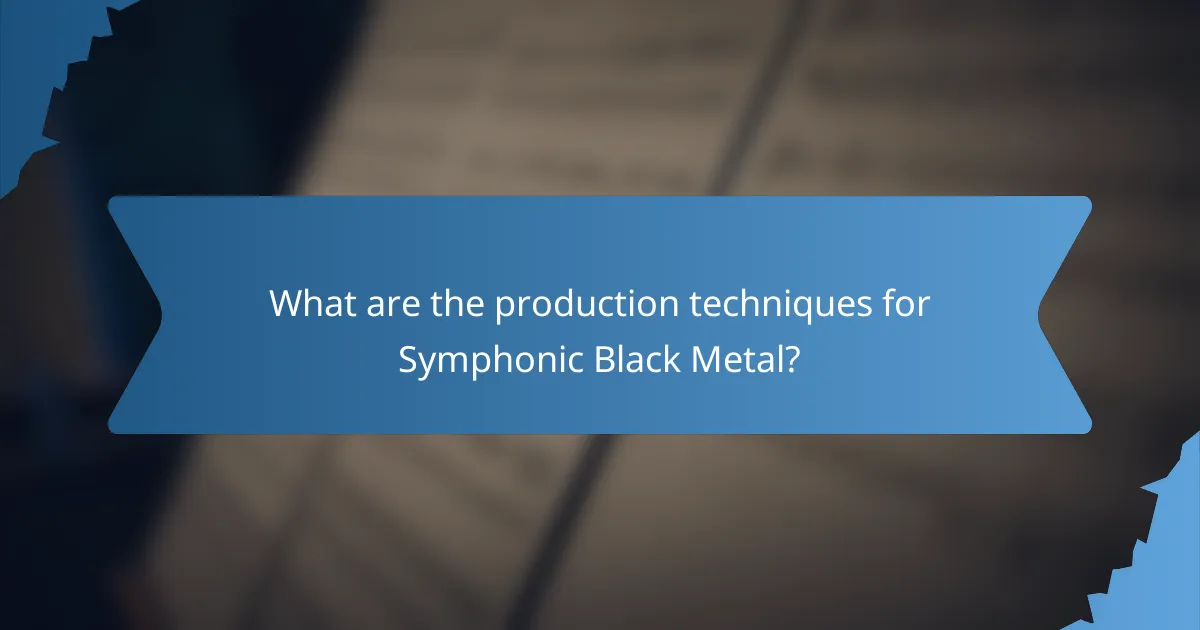Symphonic Black Metal merges the intensity of traditional black metal with lush orchestral arrangements, resulting in a dramatic and immersive soundscape. This genre is characterized by its melodic elements and theatrical performances, elevating the music to a grand, cinematic experience. By fusing heavy metal with classical influences, Symphonic Black Metal offers a rich and layered auditory journey that captivates listeners.

What are the key elements of Symphonic Black Metal?
Symphonic Black Metal combines traditional black metal with orchestral elements, creating a rich and dramatic sound. Key elements include orchestral arrangements, melodic components, and theatrical performances that enhance the overall experience.
Orchestral arrangements
Orchestral arrangements in Symphonic Black Metal incorporate strings, brass, and woodwinds alongside electric guitars and drums. These arrangements can range from subtle background layers to prominent features that drive the music’s emotional intensity.
When composing orchestral parts, consider the balance between the metal instrumentation and the symphonic elements. Using a full orchestra can create a grand sound, while smaller ensembles may provide a more intimate atmosphere. Many bands utilize digital orchestration tools to achieve these effects without the need for a live orchestra.
Melodic elements
Melodic elements in Symphonic Black Metal often include sweeping guitar solos, haunting vocal lines, and intricate keyboard passages. These melodies are typically layered to create a lush soundscape that complements the aggressive nature of black metal.
Incorporating various scales, such as harmonic minor or Phrygian, can enhance the dark and mystical qualities of the music. Experimenting with different melodic structures and motifs can lead to unique compositions that stand out within the genre.
Theatrical performance
Theatrical performance is a hallmark of Symphonic Black Metal, with bands often adopting elaborate stage setups and costumes. This visual aspect enhances the storytelling inherent in the music, drawing the audience into a captivating experience.
Consider incorporating elements such as lighting effects, props, and visual backdrops to create an immersive atmosphere. Engaging with the audience through dramatic gestures and interactions can further elevate the performance, making it memorable and impactful.

How does Symphonic Black Metal differ from traditional Black Metal?
Symphonic Black Metal incorporates orchestral elements and melodic structures, setting it apart from traditional Black Metal, which typically emphasizes raw sound and aggression. This genre blends heavy metal with classical music influences, creating a more layered and expansive listening experience.
Incorporation of orchestral instruments
Symphonic Black Metal often features a variety of orchestral instruments such as strings, brass, and woodwinds, which enhance the overall sound. These instruments add depth and texture, allowing for a more grandiose atmosphere compared to the straightforward guitar and drum setups of traditional Black Metal.
Common orchestral arrangements might include lush string sections or haunting choirs, which can elevate the emotional impact of the music. Bands like Dimmu Borgir and Cradle of Filth exemplify this integration, using orchestras to create a cinematic quality in their compositions.
Focus on melody and harmony
Unlike traditional Black Metal, which often prioritizes dissonance and harshness, Symphonic Black Metal emphasizes melody and harmony. This focus allows for more intricate compositions that can be both aggressive and beautiful, appealing to a wider audience.
Melodic elements are frequently woven into the guitar riffs and vocal lines, creating memorable hooks. This approach can make the music more accessible while still retaining the dark themes typical of the genre.
Theatrical stage presence
Theatricality is a hallmark of Symphonic Black Metal performances, often incorporating elaborate costumes, stage setups, and visual effects. This enhances the storytelling aspect of the music, drawing the audience into a dramatic experience.
Performers may use props, lighting, and multimedia elements to create an immersive atmosphere. Bands often aim to evoke a sense of fantasy or horror, making live shows not just concerts but theatrical events that leave a lasting impression on attendees.

What are the best Symphonic Black Metal bands in Australia?
Australia boasts several notable Symphonic Black Metal bands that blend orchestral arrangements with melodic elements. Key players in this genre include Ne Obliviscaris, Lord, and Alchemist, each bringing a unique sound and theatrical performance style to the scene.
Ne Obliviscaris
Ne Obliviscaris is renowned for their intricate compositions that seamlessly integrate classical music with heavy metal. Their use of violins alongside traditional metal instrumentation creates a rich, layered sound that captivates audiences.
The band’s theatrical performances often feature elaborate visuals and dynamic stage presence, enhancing the overall experience. Their albums, such as “Portal of I,” showcase a blend of aggressive riffs and melodic passages, making them a standout in the Australian metal scene.
Lord
Lord combines elements of power metal with symphonic black metal, resulting in a distinctive sound characterized by soaring melodies and orchestral arrangements. Their music often features grandiose choruses and complex guitar work, appealing to fans of both genres.
Live performances by Lord are marked by high energy and engaging theatrics, often incorporating visual effects that complement their music. Albums like “Set in Stone” highlight their ability to merge symphonic elements with traditional metal, making them a prominent band in Australia.
Alchemist
Alchemist is known for their experimental approach to metal, incorporating diverse influences that range from progressive rock to ambient music. Their symphonic black metal elements are often highlighted through atmospheric soundscapes and intricate arrangements.
The band’s live shows are immersive experiences, often featuring elaborate lighting and visuals that enhance their unique sound. With albums like “Austral Alien,” Alchemist has carved out a niche that blends heavy riffs with a distinctively atmospheric quality, appealing to a wide range of metal fans.

How to create a Symphonic Black Metal composition?
Creating a Symphonic Black Metal composition involves blending traditional black metal elements with orchestral arrangements and melodic structures. Focus on integrating heavy guitar riffs, symphonic instrumentation, and theatrical performance to achieve a rich, immersive sound.
Choosing orchestral instruments
Selecting the right orchestral instruments is crucial for establishing the symphonic aspect of your composition. Common choices include strings (violins, cellos), brass (trumpets, trombones), and woodwinds (flutes, clarinets), which can add depth and emotion to your music.
Consider using a full orchestra or a smaller ensemble depending on your budget and the desired sound. For instance, a string quartet can create an intimate atmosphere, while a full orchestra can produce a grand, cinematic effect.
Integrating melodic lines
Melodic lines in Symphonic Black Metal should complement the heavy guitar riffs while maintaining a distinct identity. Use motifs that can be developed and varied throughout the piece, ensuring they resonate with the overall theme.
Experiment with counterpoint, where different melodies interact, creating a rich tapestry of sound. Aim for a balance between melodic complexity and accessibility to keep listeners engaged.
Crafting theatrical elements
Theatrical elements can elevate a Symphonic Black Metal composition, making it more engaging for live performances. Incorporate dramatic dynamics, tempo changes, and narrative themes to create a compelling experience.
Consider using visual elements such as stage props or costumes that align with the music’s themes. This not only enhances the performance but also deepens the audience’s emotional connection to the piece.

What are the common themes in Symphonic Black Metal lyrics?
Symphonic Black Metal lyrics often explore deep and complex themes, reflecting a blend of fantasy, existential thought, and the natural world. These themes are expressed through vivid imagery and intricate storytelling, creating a rich tapestry that enhances the music’s dramatic and orchestral elements.
Fantasy and mythology
Fantasy and mythology are prevalent themes in Symphonic Black Metal, often drawing inspiration from ancient tales, folklore, and legendary figures. Lyrics may reference gods, mythical creatures, or epic battles, creating a sense of grandeur and escapism. Bands frequently weave narratives that transport listeners to otherworldly realms, enhancing the theatricality of their performances.
For example, a song might depict a hero’s journey through a mystical forest, battling dark forces. This storytelling approach not only captivates the audience but also complements the orchestral arrangements, making the music feel cinematic.
Existentialism
Existentialism is another significant theme, with lyrics exploring the nature of existence, identity, and the human condition. Many bands reflect on themes of despair, isolation, and the search for meaning in a chaotic world. This introspective approach resonates with listeners who grapple with similar feelings, creating a connection through shared experiences.
Common motifs include questioning one’s purpose or confronting mortality, often expressed in a poetic and philosophical manner. This depth adds a layer of complexity to the music, inviting listeners to reflect on their own lives and beliefs.
Nature and the cosmos
The natural world and cosmic elements frequently appear in Symphonic Black Metal lyrics, emphasizing the beauty and terror of the universe. Lyrics may evoke imagery of vast landscapes, celestial bodies, and the forces of nature, highlighting humanity’s smallness in the grand scheme of things. This theme often serves to underscore the emotional weight of the music.
For instance, a song might describe a stormy night under a full moon, using vivid descriptions to create an atmosphere that mirrors the intensity of the music. This connection between lyrical content and musical composition enhances the overall experience, making it both immersive and thought-provoking.

What are the production techniques for Symphonic Black Metal?
Production techniques for symphonic black metal combine traditional metal elements with orchestral arrangements to create a rich, layered sound. Key methods include layering orchestral sounds, mixing metal with symphonic elements, and utilizing digital audio workstations for precise control over the final mix.
Layering orchestral sounds
Layering orchestral sounds involves integrating various instruments such as strings, brass, and woodwinds to enhance the depth of the music. This technique can create a cinematic atmosphere, making the music feel grand and expansive. When layering, consider using different articulations and dynamics to add realism and complexity.
A common approach is to use multiple tracks for each orchestral section, allowing for adjustments in volume and panning to create a three-dimensional sound. For instance, placing violins slightly forward in the mix while keeping cellos and basses more subdued can help achieve a balanced orchestral texture.
Mixing metal and symphonic elements
Mixing metal and symphonic elements requires careful attention to ensure that neither aspect overshadows the other. The heavy guitar riffs and aggressive drumming typical of black metal must coexist with the lush orchestral sounds. Achieving this balance often involves EQ adjustments, where frequencies of the metal instruments are sculpted to prevent clashing with orchestral tones.
Additionally, consider using reverb and delay effects to create a cohesive sound. For example, applying a longer reverb on orchestral elements can help them blend seamlessly with the more aggressive metal components, enhancing the overall atmosphere of the track.
Use of digital audio workstations
Digital audio workstations (DAWs) are essential for producing symphonic black metal, providing tools for recording, editing, and mixing. Popular DAWs like Ableton Live, FL Studio, and Logic Pro offer advanced features that facilitate orchestral arrangement and metal production. Utilizing MIDI instruments within these platforms allows for precise control over orchestral sounds and their integration with metal elements.
When working in a DAW, take advantage of plugins that emulate orchestral instruments, as they can save time and resources. However, be cautious of over-relying on presets; customizing sounds can lead to a more unique and personal production. Regularly save your work and create backups to avoid losing progress during complex sessions.
